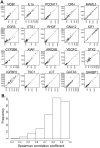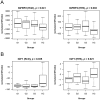Identification of candidate serum proteins for classifying well-differentiated small intestinal neuroendocrine tumors
- PMID: 24282616
- PMCID: PMC3839889
- DOI: 10.1371/journal.pone.0081712
Identification of candidate serum proteins for classifying well-differentiated small intestinal neuroendocrine tumors
Abstract
Background: Patients with well-differentiated small intestine neuroendocrine tumors (WD-SI-NETs) are most often diagnosed at a metastatic stage of disease, which reduces possibilities for a curative treatment. Thus new approaches for earlier detection and improved monitoring of the disease are required.
Materials and methods: Suspension bead arrays targeting 124 unique proteins with antibodies from the Human Protein Atlas were used to profile biotinylated serum samples. Discoveries from a cohort of 77 individuals were followed up in a cohort of 132 individuals both including healthy controls as well as patients with untreated primary WD-SI-NETs, lymph node metastases and liver metastases.
Results: A set of 20 antibodies suggested promising proteins for further verification based on technically verified statistical significance. Proceeding, we assessed the classification performance in an independent cohort of patient serum, achieving, classification accuracy of up to 85% with different subsets of antibodies in respective pairwise group comparisons. The protein profiles of nine targets, namely IGFBP2, IGF1, SHKBP1, ETS1, IL1α, STX2, MAML3, EGR3 and XIAP were verified as significant contributors to tumor classification.
Conclusions: We propose new potential protein biomarker candidates for classifying WD-SI-NETs at different stage of disease. Further evaluation of these proteins in larger sample sets and with alternative approaches is needed in order to further improve our understanding of their functional relation to WD-SI-NETs and their eventual use in diagnostics.
Conflict of interest statement
Figures





Similar articles
-
DcR3, TFF3, and Midkine Are Novel Serum Biomarkers in Small Intestinal Neuroendocrine Tumors.Neuroendocrinology. 2017;105(2):170-181. doi: 10.1159/000452891. Epub 2016 Nov 9. Neuroendocrinology. 2017. PMID: 27829249
-
Paraneoplastic antigen Ma2 autoantibodies as specific blood biomarkers for detection of early recurrence of small intestine neuroendocrine tumors.PLoS One. 2010 Dec 30;5(12):e16010. doi: 10.1371/journal.pone.0016010. PLoS One. 2010. PMID: 21209860 Free PMC article.
-
Differential Protein Expression in Small Intestinal Neuroendocrine Tumors and Liver Metastases.Pancreas. 2016 Apr;45(4):528-32. doi: 10.1097/MPA.0000000000000459. Pancreas. 2016. PMID: 26474427 Free PMC article.
-
Update on medical treatment of small intestinal neuroendocrine tumors.Expert Rev Anticancer Ther. 2016 Sep;16(9):969-76. doi: 10.1080/14737140.2016.1207534. Epub 2016 Jul 13. Expert Rev Anticancer Ther. 2016. PMID: 27353232 Review.
-
Small intestinal neuroendocrine tumours and fibrosis: an entangled conundrum.Endocr Relat Cancer. 2018 Mar;25(3):R115-R130. doi: 10.1530/ERC-17-0380. Epub 2017 Dec 12. Endocr Relat Cancer. 2018. PMID: 29233841 Review.
Cited by
-
Mastermind Like Transcriptional Coactivator 3 (MAML3) Drives Neuroendocrine Tumor Progression.Mol Cancer Res. 2021 Sep;19(9):1476-1485. doi: 10.1158/1541-7786.MCR-20-0992. Epub 2021 May 13. Mol Cancer Res. 2021. PMID: 33986121 Free PMC article.
-
KCTD: A new gene family involved in neurodevelopmental and neuropsychiatric disorders.CNS Neurosci Ther. 2019 Jul;25(7):887-902. doi: 10.1111/cns.13156. CNS Neurosci Ther. 2019. PMID: 31197948 Free PMC article. Review.
-
circ-SHKBP1 Regulates the Angiogenesis of U87 Glioma-Exposed Endothelial Cells through miR-544a/FOXP1 and miR-379/FOXP2 Pathways.Mol Ther Nucleic Acids. 2018 Mar 2;10:331-348. doi: 10.1016/j.omtn.2017.12.014. Epub 2017 Dec 30. Mol Ther Nucleic Acids. 2018. PMID: 29499945 Free PMC article.
-
Current applications of antibody microarrays.Clin Proteomics. 2018 Feb 28;15:7. doi: 10.1186/s12014-018-9184-2. eCollection 2018. Clin Proteomics. 2018. PMID: 29507545 Free PMC article. Review.
-
The emerging role of the KCTD proteins in cancer.Cell Commun Signal. 2021 May 17;19(1):56. doi: 10.1186/s12964-021-00737-8. Cell Commun Signal. 2021. PMID: 34001146 Free PMC article. Review.
References
-
- Kloppel G, Couvelard A, Perren A, Komminoth P, McNicol AM, et al. (2009) ENETS Consensus Guidelines for the Standards of Care in Neuroendocrine Tumors: towards a standardized approach to the diagnosis of gastroenteropancreatic neuroendocrine tumors and their prognostic stratification. Neuroendocrinology 90: 162–166. - PubMed
-
- Neiman M, Hedberg JJ, Donnes PR, Schuppe-Koistinen I, Hanschke S, et al. (2011) Plasma profiling reveals human fibulin-1 as candidate marker for renal impairment. Journal of proteome research 10: 4925–4934. - PubMed
-
- Schwenk JM, Gry M, Rimini R, Uhlen M, Nilsson P (2008) Antibody suspension bead arrays within serum proteomics. Journal of proteome research 7: 3168–3179. - PubMed
Publication types
MeSH terms
Substances
LinkOut - more resources
Full Text Sources
Other Literature Sources
Miscellaneous

